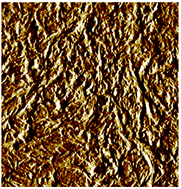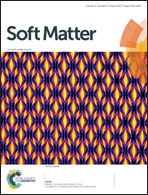Surface shear viscosity as a macroscopic probe of amyloid fibril formation at a fluid interface
Abstract
Amyloidogenesis of proteins is of wide interest because amyloid structures are associated with many diseases, including Alzheimer's and type II diabetes. Dozens of different proteins of various sizes are known to form amyloid fibrils. While there are numerous studies on the fibrillization of insulin induced by various perturbations, shearing at fluid interfaces has not received as much attention. Here, we present a study of human insulin fibrillization at room temperature using a deep-channel surface viscometer. The hydrodynamics of the bulk flow equilibrates in just over a minute, but the proteins at the air–water interface exhibit a very slow development during which the surface (excess) shear viscosity deduced from a Newtonian surface model increases slightly over a period of a day and a half. Then, there is a very rapid increase in the surface shear viscosity to effectively unbounded levels as the interface becomes immobilized. Atomic force microscopy shows that fibrils appear at the interface after it becomes immobilized. Fibrillization in the bulk does not occur until much later. This has been verified by concurrent atomic force microscopy and circular dichroism spectroscopy of samples from the bulk. The immobilized interface has zero in-plane shear rate, however due to the bulk flow, there is an increase in the strength of the normal component of the shear rate at the interface, implicating this component of shear in the fibrillization process ultimately resulting in a thick weave of fibrils on the interface. Real-time detection of fibrillization via interfacial rheology may find utility in other studies of proteins at sheared interfaces.



 Please wait while we load your content...
Please wait while we load your content...